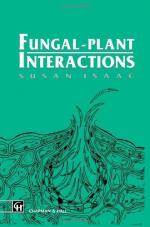|
This section contains 341 words (approx. 2 pages at 300 words per page) |
Fungi are the most common parasites of plants, causing many kinds of diseases. Nonetheless, a fungus often parasitizes a plant without causing harm, and it may even be beneficial. Two well-known examples of beneficial fungi are the mycorrhizae and fescue endophytes.
A mycorrhiza is a fungus-root association in which the fungus infects the root without causing harm. In fact, the plant often benefits because the fungal hyphae in the soil obtain mineral nutrients that are some distance from the root. Ectomycorrhizae are commonly found on both hardwood and coniferous trees in the forest or yard. A fungal mantle covers the root, and a network of hyphae can be found between cells in the root cortex. A special benefit of this mycorrhiza is that pathogens cannot penetrate the root. Many different fungi may serve as the fungal symbiont. A mushroom or puffball in the forest may be evidence of an ectomycorrhizal association.
Vesicular-arbuscular (VA) mycorrhizae are common in crop plants all over the world. These endomycorrhizae have no fungal mantle but have extensive hyphae in the root cortex. Many branched hyphal structures called arbuscules invade cells and obtain food. The vesicles, ball-like structures found between cortical cells, seem to serve in food storage. The VA mycorrhizal fungi are all closely related and obligate parasites.
The tall fescue endophyte Acremonium is a parasite that does not harm the plant. However, the infected grass is toxic to cattle. Endophyte-infected plants benefit by having greater stress tolerance and resistance to attack by insects. Endophyte-infected fescue is already being used as turfgrass, where the benefits can be realized without fear of toxicity to cattle. This character is readily maintained since the endophyte fungus is transmitted through the seed.
See Also
Chestnut Blight; Dutch Elm Disease; Interactions, Plant-Insect; Mycorrhizae; Pathogens; Potato Blight.
Bibliography
Smith, Sally E., and David J. Read. Mycorrhizal Symbiosis, 2nd ed. San Diego, CA: Academic Press, 1997.
Stuedemann, John A., and Carl S. Hoveland. "Fescue Endophyte: History and Impact on Animal Agriculture." Journal of Production Agriculture 1 (1988): 39-44.
 Budded hyphae magnified two hundred times.
Budded hyphae magnified two hundred times.
|
This section contains 341 words (approx. 2 pages at 300 words per page) |


